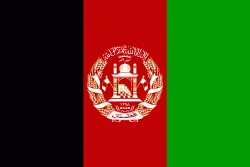Nirkh District (Nirkh)
Nirkh or Narkh is a district of about 480 square kilometres (185 sq. mi.) in the east of Wardak Province, Afghanistan. Its population was estimated at 57,000 in 2002, consisting of about 99% Pashtuns, % Tajiks and 1% Hazara. The district centre is Kane Ezzat.
During the presidency of Mohammed Daoud Khan in the 1970s, Nirkh District was planted with many fruit trees; however, these have since dried up in droughts.
It was reported on 17 November 2009 that Afghan and NATO forces killed one farmer and a militant during an operation.
It was reported on 20 November that a suspected militant was detained when several compounds used by the Taliban for IED and small arms attacks were searched. The incident occurred in Darmandyan.
On 12 May 2021 it was captured by Taliban.
During the presidency of Mohammed Daoud Khan in the 1970s, Nirkh District was planted with many fruit trees; however, these have since dried up in droughts.
It was reported on 17 November 2009 that Afghan and NATO forces killed one farmer and a militant during an operation.
It was reported on 20 November that a suspected militant was detained when several compounds used by the Taliban for IED and small arms attacks were searched. The incident occurred in Darmandyan.
On 12 May 2021 it was captured by Taliban.
Map - Nirkh District (Nirkh)
Map
Country - Afghanistan
 |
 |
| Flag of Afghanistan | |
Human habitation in Afghanistan dates back to the Middle Paleolithic era, and the country's strategic location along the historic Silk Road has led it to being described, picturesquely, as the ‘roundabout of the ancient world’. Popularly referred to as the graveyard of empires, the land has historically been home to various peoples and has witnessed numerous military campaigns, including those by the Persians, Alexander the Great, the Maurya Empire, Arab Muslims, the Mongols, the British, the Soviet Union, and most recently by a US-led coalition. Afghanistan also served as the source from which the Greco-Bactrians and the Mughals, amongst others, rose to form major empires. The various conquests and periods in both the Iranian and Indian cultural spheres made the area a center for Zoroastrianism, Buddhism, Hinduism, and later Islam throughout history.
Currency / Language
| ISO | Currency | Symbol | Significant figures |
|---|---|---|---|
| AFN | Afghan afghani | Ø‹ | 2 |
| ISO | Language |
|---|---|
| PS | Pashto language |
| FA | Persian language |
| TK | Turkmen language |
| UZ | Uzbek language |















